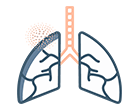Primary Ciliary Dyskinesia Precision Panel
Primary Ciliary Dyskinesia (PCD) is a highly heterogeneous syndrome characterized by congenital impairment of mucociliary clearance (MCC). The underlying cause is a defect of cilia in the airways, making them unable to beat normally and move respiratory secretions.




